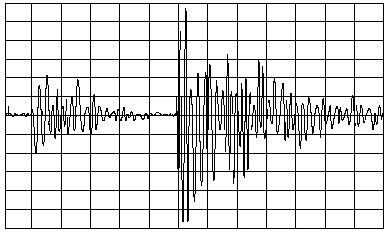
|
Of course, real earthquakes are not sinusoidal in nature, but are much more random, like the figure below. Nevertheless, the frequencies present in actual earthquake ground motions do lie within certain ranges, (mostly between 0.5 Hz and 10.0 Hz). Random ground motion can therefore be thought of as a summation of several sinusoidal ground motions, all with slightly different frequencies and with different phase angles. With the concept of a random ground motion being essentially the summation of several sinusoids, we can conceptualize the response to random ground motion as the summation of the responses to each of the sinusoidal ground motions, individually. If the random ground motion includes frequencies at or near a natural frequency of the building, then the building will respond strongly at that natural frequency.

|